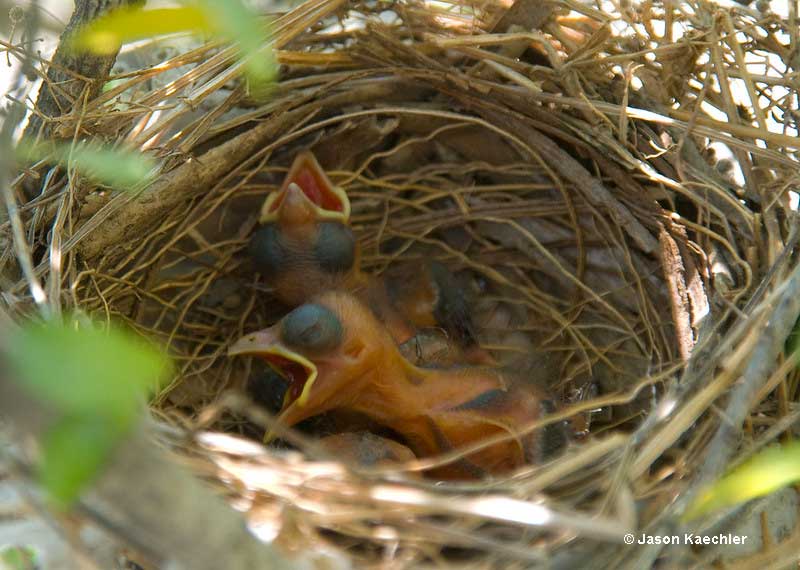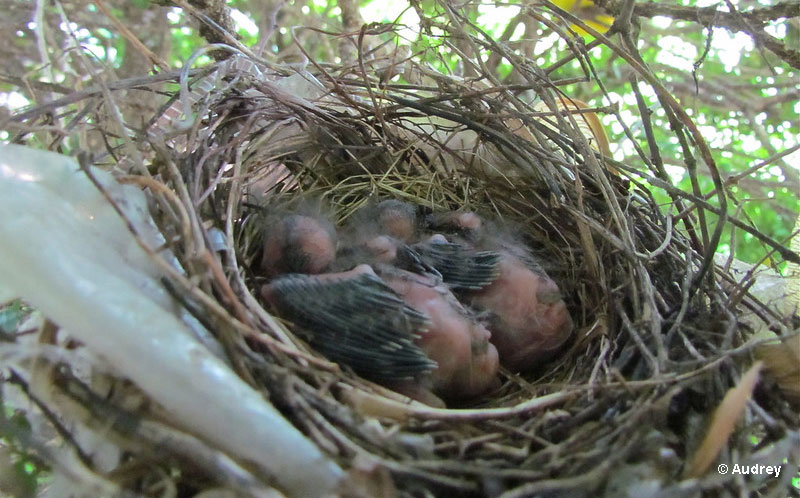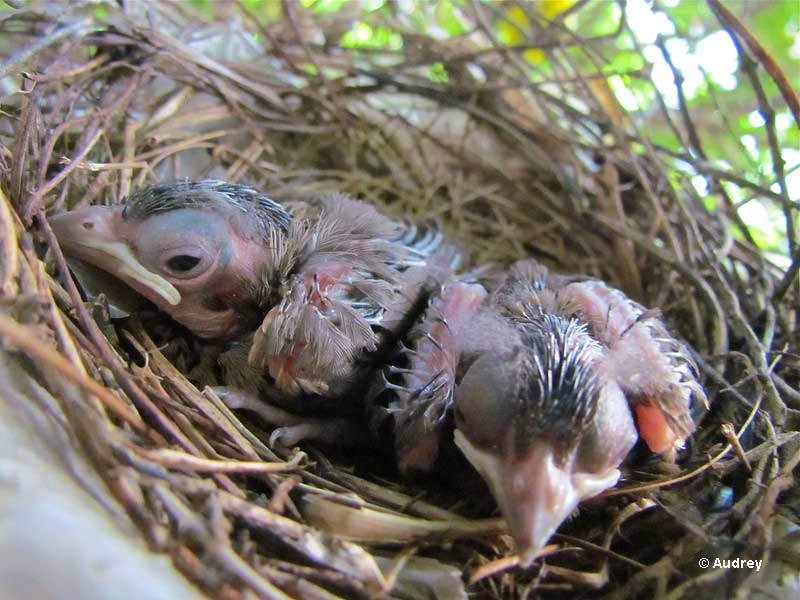
Cardinals are known for their red plumage and fierce behavior, but that’s not the case with their young.
Baby cardinals hatch as tiny, naked, and completely helpless birds. Although they grow fast, baby cardinals still have a few challenges to face.
- What Does a Baby Cardinal Look Like?
- Nest
- How to Tell Baby Cardinals Apart?
- What Do Baby Cardinals Eat?
- What Does a Baby Cardinal Look Like?
- How Long Do Baby Cardinals Stay With Their Parents?
- How Long Does It Take for a Baby Cardinal to Turn Red?
- What Time of Year Are Baby Cardinals Born?
- Is the Northern Cardinal the state bird of any states?
Keep reading to find out what makes the first few weeks of their life so special!
What Does a Baby Cardinal Look Like?
At first, a baby cardinal doesn’t look anything like its beautiful red, black, and gray parents.
After hatching, it lacks adult feathers but has some gray, fuzzy down feathering, doesn’t even open its eyes, and is very small. These tiny birds only weigh 3.5 grams, about as much as a 1/4 teaspoon of sugar, or a penny!
The hatchling birds have transparent skin with a yellowish coloration, and the only other color they show is when they open their mouths to receive food. The inside of the mouth is a bright orange-red with yellow at the edges. These colors may encourage and help adults to feed them better.
However, baby cardinals grow fast, and after a few days, they have bits of gray feathers growing in on various parts of their bodies. By the time they leave the nest, although the babies still lack the red colors of their parents, they are covered in soft feathers and even show a short tail and a hint of a crest.
For the next two weeks, they spend most of their time hiding in dense vegetation and catching their own food while still being occasionally fed by parents. After two weeks, most young cardinals are about the same size as an adult, even if they have gray instead of orange or red feathers.
Nest
The female Northern Cardinal builds a cup-shaped nest in a shrub or small tree, often in a dense thicket or vine tangle, and usually five to six feet above the ground. The nest is made of four distinct layers and is placed in the fork of twigs or branches.
The mother cardinal builds it with bark, stems, grasses, vines, and other bits of vegetation, using larger twigs for the outer layer, grapevine bark for the next layer, and then puts a layer of leaves under a nest lining of soft grass. The size of cardinal nests varies, but on average, they have a height of 2.6 inches, a depth of 1.4 inches, and a diameter of 4.25 inches.
Two to five eggs are laid and incubated by the female for around two weeks. The eggs are oval, weigh 4.9 grams on average, and can be pale green, cream, or buff with gray or brown marks and speckling.
Upon hatching, the baby cardinals are naked, helpless, and the only movement they can make is that of opening their mouths.
Related: Do cardinals mate for life?
However, they grow quickly and usually leave the nest just nine or ten days after hatching. While they are growing, baby cardinals don’t move much, but when the parents arrive, they immediately stretch their necks up, open their mouths to receive food, and make high-pitched begging calls.
How to Tell Baby Cardinals Apart?
In the nest, baby cardinals look like most other young songbirds. They lack the colors and structure we use to identify adults and, therefore, can only be identified by the structure of the nest and seeing adult birds visit and attend the young.
However, once the young birds depart the nest, they can be identified by their gray coloration, crest, and finch-like bill. They can also make a chip note that sounds like the adult, and are found in the same habitat; dense shrubbery and second growth.
Eventually, the young cardinals grow a medium-length tail and attain a brownish plumage with dull red highlights.
What Do Baby Cardinals Eat?
Baby cardinals are hungry little birds that start feeding shortly after hatching. They can be fed two, five, or even eight times per hour and large broods can be fed even more frequently.
Related: What do baby birds eat?
To help them grow and leave the nest as soon as they can, the feeding rate for baby cardinals also goes up as the baby birds get bigger. Both parents are kept busy feeding their babies throughout the day.
Although adult birds feed on seeds and fruit quite often, to provide babies with high levels of protein needed for growth, they only feed their babies insects and other small creatures.
Nestling cardinals are fed a wide variety of insects, probably just about any insect that the adult can catch. These include beetles, grasshoppers, mantises, butterflies, moths, katydids, dragonflies, cicadas, and other species. In addition to insects, cardinals sometimes bring snails and small mollusks to their young.
Food can be regurgitated and fed to the babies, but bugs are usually mashed up or broken into pieces which are then placed into the waiting mouths of the baby birds.
What Does a Baby Cardinal Look Like?
Baby cardinals are tiny and delicate creatures, mostly naked with only a sparse covering of soft gray down feathers.
When they first hatch, their eyes are closed, and their large yellowish beaks appear oversized in contrast to their small heads and frail bodies. This vulnerable stage highlights their complete reliance on parental care for warmth, food, and protection.
Distinguishing baby cardinals from other hatchlings is possible by observing their early feather color and the shape of their beaks. Beyond their physical traits, the appearance of these fledglings is often seen as a reflection of nature’s cycles of dependency and growth, offering a poignant metaphor for nurturing and resilience.
How Long Do Baby Cardinals Stay With Their Parents?
Baby cardinals typically stay in the nest for around ten days after hatching.
During this time, their parents feed them constantly, ensuring they receive the nutrition needed for growth. Once they leave the nest, the fledglings remain dependent on their parents for weeks, often being fed for anywhere between 25 days and up to eight weeks.
The commitment of both male and female cardinals to feeding and protecting their young showcases an impressive example of shared parenting in the bird world.

Watching fledglings after they leave the nest can be fascinating, as they frequently exhibit characteristic begging behavior, such as head-bobbing and chirping to solicit food from their parents.
How Long Does It Take for a Baby Cardinal to Turn Red?
It can take up to a year for a young male cardinal to develop its iconic bright red plumage, a process that is closely tied to their molting cycles.
During this time, males gradually transition from the muted grayish-brown tones of their juvenile feathers to the vivid red that makes them so recognizable. Female cardinals, by contrast, retain a subtler brownish coloration with red highlights throughout their lives.
This difference in plumage plays a significant role in survival and reproduction; the bright red coloration of adult males makes them more attractive to potential mates, while the subdued colors of juveniles help camouflage them from predators.
The transformation of a male cardinal’s feathers is not just a visual change but also an evolutionary strategy that balances safety during youth with reproductive success in adulthood.
What Time of Year Are Baby Cardinals Born?
Baby cardinals are primarily born in the spring, with most eggs hatching in April and May.
However, cardinals are unique in that they have an extended breeding season, often raising two or three broods each year. This means that while spring is their peak nesting period, it’s not uncommon to find fledglings as late as September.

This extended season is an adaptation that allows them to make the most of favorable conditions, such as an abundance of food like berries and insects during warmer months.
The timing of their hatching ensures the highest chance of survival for their young, aligning perfectly with the availability of resources needed for growth and development.
Additional Perspectives
The lives of baby cardinals offer a window into the complex relationships and challenges within the natural world.
For backyard birdwatchers, creating a safe environment can significantly impact the survival of these birds. Providing dense shrubs for nesting and avoiding disturbances near nests can help protect them from predators like snakes or blue jays.
Additionally, the symbolism of cardinals as messengers of hope and vitality extends to their young, with fledglings often representing renewal and new beginnings in cultural and personal interpretations.
Is the Northern Cardinal the state bird of any states?
Northern Cardinal happens to be a state bird for 7 states: Illinois, Indiana, Kentucky, North Carolina, Ohio, Virginia and West Virginia
Read next: What to do if you find a baby bird




Nakina
Tuesday 30th of July 2024
I have a cardinal nest in my living tree with a new fledgling baby. That is about three days old. I’m concerned because I haven’t seen the parents come back to feed in about a day and a half. It’s possible I have missed them. How often do they come back to the nest to feed?
Patrick O'Donnell
Wednesday 31st of July 2024
@Nakina- When baby cardinals are ready to leave the nest, to encourage them to leave, their parents don't visit the nest as often. This may be what was happening.
Cindy
Tuesday 2nd of July 2024
How long does it take for the baby cardinals beak to change from dark to the orange adult color ?
Cindy
Wednesday 3rd of July 2024
@Patrick O'Donnell, Thanks so much Patrick!
Patrick O'Donnell
Wednesday 3rd of July 2024
@Cindy- Juvenile cardinals start to have orange beaks around two to four months after hatching. They usually start showing those colors by the end of summer and early fall.
Frances
Friday 24th of May 2024
We have a nest in a yew and saw one baby about 3days ago. Dad is always around. When I looked today, the chick appeared to be flat on its back in the nest! I thought it was dead but could see its heart beating! So upsetting. I left it alone as Dad is close by. Should I do anything or let nature take its course?
Patrick O'Donnell
Tuesday 28th of May 2024
@Frances- Although it can be upsetting to see a baby bird like that, it's hard to know if it has a problem or not. Since it's in the nest, we should just let its parents care for it. If the nestling did have some problem, there's very little you can do anyways.
Janet
Sunday 16th of July 2023
We found a baby cardinal on our farm. It kept going towards the fire. When we moved it away from the fire our dog went after it. I have been feeding it moistened dog kibble. It is doing well. It can fly. It calls to be fed, about 3 x's an hour until sunset. I do not know how to prepare it to be let go. What would you suggest?
Patrick O'Donnell
Tuesday 18th of July 2023
@Janet- Good thing you saved that baby cardinal from the fire and your dog! When we find a baby bird, the best thing to do is to put it in a shrub or low tree near where you found it.
In all likelihood, its parents are close by. Sometimes, like the bird on your farm, we do need to save the baby bird from hazards like roads, pets, or other things. However, after saving it, if the baby bird has feathers and can fly, we should put it back into the wild as soon as possible.
Preferably, we should release the bird near its nest but if we don't know where the nest is, the next best thing is to release the baby bird in the closest suitable vegetation. In your case, that might be the edge of some woods or bushes far enough from the house to keep pets from attacking the baby.
The bird will still call and beg for food but its parents should be nearby and should find and feed it.